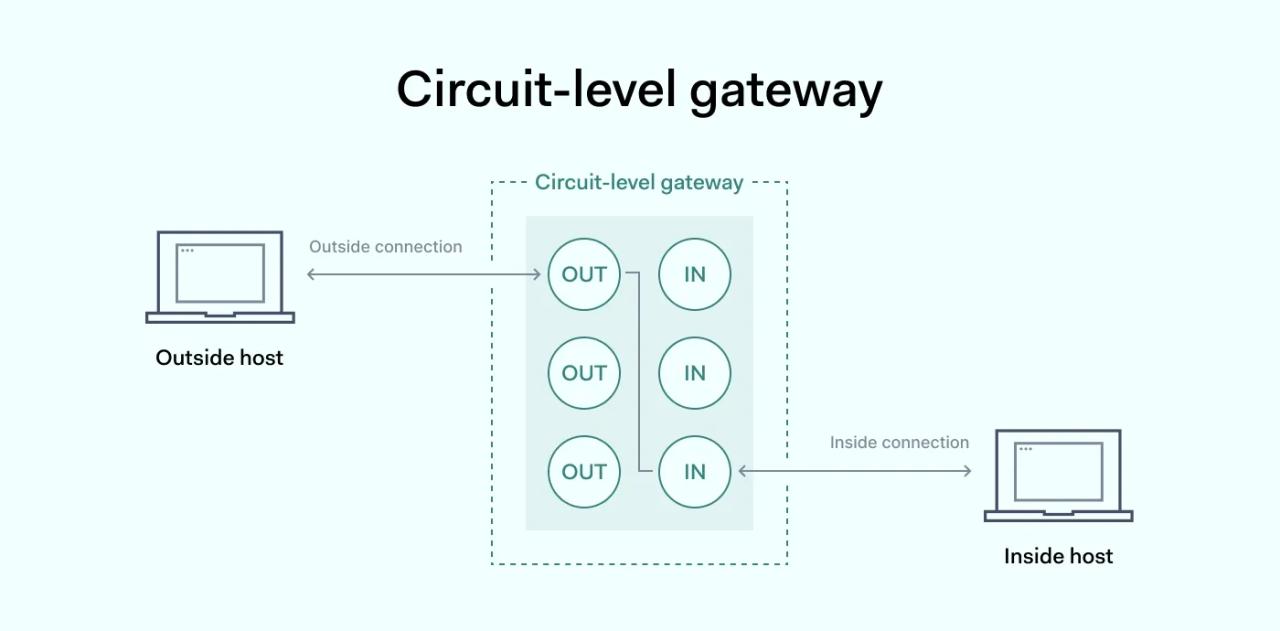A circuit level gateway is a solution designed to provide connection security to internal and external computers in a network's session layer. Unlike application gateways, circuit level firewalls do not engage in packet filtering based on the packet's contents. It verifies the transmission control protocol (TCP) or user datagram protocol (UDP) packets on a virtual circuit between the two transport layers.
Circuit level gateway definition
A circuit level gateway works at the session layer of the open systems interconnection (OSI) model. The firewall analyzes transmission control protocol handshaking between packets to identify legitimate traffic and block unauthorized access attempts. Only the header information is checked to ensure that the traffic meets the circuit level gateway rules, while the content of data packets is skipped. It handles connections between trusted servers and clients with untrusted hosts.
How does a circuit level gateway work
Circuit level gateways are designed to control and monitor traffic flow based on network connections' state.

- When a user initiates a connection to a remote host, the circuit level gateway sets up a circuit or a virtual connection between the user and the remote host.
- The circuit level gateway then monitors the traffic flowing over this circuit, checking whether the traffic belongs to an established connection and allowing only authorized traffic to pass through.
Validated transmission control protocol or user datagram protocol connections then interact with a destination server on behalf of the client. Otherwise the connection is rejected, terminating the session.
Overview of circuit level gateway operations
By regulating connection flow, circuit level gateways examine TCP or UDP protocol's traffic within a packet to determine whether it meets the circuit level gateway rules. The firewall creates a virtual circuit or connection between internal and external computers to assess the traffic passing between them. The traffic can pass through to the internal client if it meets the circuit level gateway rules.
Analysis of packets and communication
The circuit level gateway analyzes the header information checking incoming traffic and whether it aligns. The source and destination IP addresses, ports, sequence, and acknowledgment numbers are checked to identify legitimate traffic. If the packet contains invalid header information or breaches other firewall rules, the traffic is blocked, and the connection is terminated.
Implementation of firewall rules
A set of rules govern how a circuit level gateway operates. These rules determine which traffic rules can pass through the circuit level gateway and which traffic should be blocked. Cross-referencing this data with parameters like source and destination IP addresses, protocol type, and port numbers allows network administrators to have granular control over network session layer.
Advantages of a circuit level gateway
For organizations, circuit level gateway offers some clear advantages. Here's the list of the most significant of them.
Improved performance
Circuit level firewalls are generally faster and less resource-intensive unlike application gateways and other firewall solutions. This is because they operate at a lower network stack level and only monitor traffic at the session level. For this reason, they are also less likely to introduce latency or impact network performance.
Simple to configure
Circuit-level firewalls are easier to set up and manage than other firewall solutions. They don't require as much in-depth knowledge of the application level gateways and protocols used on the network to be configured. As the focus is solely on the connection's state, there are fewer variables than there would be with more advanced firewall types.
Cost-effective
Compared to more advanced firewall types like next generation firewalls, they operate within completely different pricing categories. Meanwhile, circuit level gateways are the cheapest option among all of their types. For this reason, this type is favored by small to medium-sized businesses with limited budgets.
Provides discreet connection security
Due to their mode of operation, circuit level gateways determine the safety of an established connection with the help of a virtual connection on behalf of an internal host. This intermediary helps to keep its identity and IP address hidden from the server. In turn, this leaves fewer breadcrumbs that hackers could use.
Choosing the right circuit level gateway for your network
Picking the right circuit level gateway for your network can be a crucial decision as it can determine the level of security against potential threats.
Identifying your network security requirements
When shopping for a circuit level gateway, it's important to identify which security areas this solution should cover within your network. It should include a thorough assessment of the sensitivity of the data on your network, the number of users, and the level of access required by each user. This initial analysis can ensure that the circuit level gateway provides optimal security for your network.
Evaluating firewall features and capabilities
While a circuit level gateway is a much more modest alternative, you should still consider its functionalities. Different setups may have different methods of how virtual circuits are established. It's important to check whether both UDP and TCP traffic is supported. In addition, additional firewall security features like intrusion detection or other filtering solutions may be added on top of core functionalities.
Assessing performance and cost-effectiveness
When assessing the performance and cost-effectiveness of a circuit level gateway, it's important to consider the amount of traffic it can handle per second. If the estimation is wrong, limited circuit level gateway capacity can be a bottleneck when handling traffic. This also ties in with the firewall's scalability regarding handling traffic and users. As an organization needs change, it's important to consider how well a firewall can be scaled up or down depending on its needs.